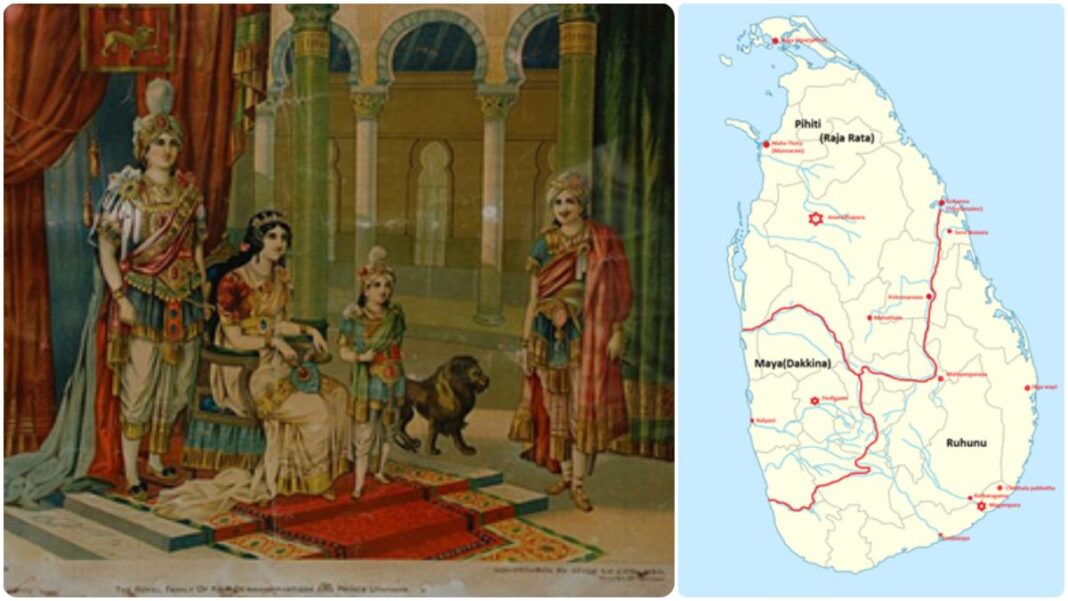In our previous articles, we re-visited the Anuradhapura Period up to the reign of Great King Devanam Piya Tissa who ruled Lanka for 40 years from 307 BC to 267 BC (please note that the modified chronology adopted by the relatively modern historians assigns his reign to 247 BC to 207 BC. In this series I choose to continue with the traditional chronology for ease).
We remember that our Great King Devanam Piya Tissa was the son of King Mutaseeva who in turn was the son of Great Hela King Pandukhabhaya. At the death of King Mutaseeva, the eldest of his ten sons, Mahanaga would have been the traditional heir to the throne; however, for several reasons, Mahanaga did not ascend to the throne, paving the way for Tissa to succeed Mutaseeva. The major reason for this choice seems to be the prediction of the palace astrologers that Tissa had the correct star alignments to be King. Mahavansa says there was a dispute between Mahanaga and Tissa regarding the throne; the Great Chronicle goes even further to say that a consort of Devanam Piya Tissa made an attempt to poison Prince Mahanaga. The poisoned mango meant for Prince Mahanaga was eaten by King Devanam Piya Tissa’s young son causing his death. Disheartened, Prince Mahanaga escaped to the Ruhuna. This highly dramatised version of events is not, however, supported by the succeeding events or the behavioural patterns of the brothers after the supposed event.
For starters, the Devanam Piya Tissa era was a stable, prosperous, and peaceful four decades; that may not have been possible if there was a disgruntled, power-hungry brother lurking to grab power.

An artistic impression of the Sinhala Royal Family of King Devanampiya Tissa and Prince Uththiya- courtesy of Wikipedia
Mahanaga located himself in the principality of Ruhuna loyal to Anuradhapura; which again believes
the theory that there was bitterness among the brothers. Boundaries of the Ruhuna kingdom (one of three sub-kingdoms of the Thun Sinhale) stretched from the Mahaveli River in the north to the Keleni River in the northwest. You may recall that according to Mahavansa, one of Queen Bhadrakactchayana’s (King Panduwasdewa’s queen consort of Sakyan descent) brothers, Rohana, settled in Ruhuna. Professor Raj Somadeva believes that Ruhuna existed even before Rohana arrived and that it was one of the centres of ancient Yakkha/ Hela people for over many thousands of years before Rohana. Therefore, Ruhuna was already established as a principality at the time Uparaja Mahanaga arrived.
The capital of Ruhuna was known as Magama, near modern-day Tissamaharama. The internationally important Port city of Magama which played a major role in international trade in the Indian Ocean in the later centuries is believed to be present-day Hambanthota. A secondary city of Mahanagakula (now Ambalanthota) also flourished under Mahanaga.
Professor Raj Somadeva opines that the reason for Uparaja Mahanaga’s departure to Ruhuna had broader reasons than a mere sibling rivalry. He believes that the widely- exercised power of the Mayuryan Empire and the budding international trade in the Indian Ocean were factors of major concern to Mahanaga; the Prince foresaw the impact of these developments on Lanka’s stability and was alarmed at Tissa’s readiness to pay allegiance to the Indian Emperor. Somadeva believes that the creation of an alternative power cell in Ruhuna was a timely strategy undertaken by the wise Prince and its correctness was proven when it was Ruhuna that – many centuries later- produced King Kavan Tissa. Kavan Tissa and his Queen Vihara Maha Devi in turn produced Prince Gamini Abhaya (Dutu Gamunu) who demolished the South Indian Dravidian invasion of Elara that took 44 years to defeat.
Prince Mahanaga became the first Prince of Ruhuna and his sons and grandsons ruled Ruhuna after him. In particular, the Ruhuna Royals built reservoirs, managed rainwater, and developed agriculture to such a great extent that when the Anuradhapura and Polonnaruwa kingdoms were in grave danger of being wiped out at the hands of the invading South Indians in the latter centuries, Ruhuna came forth as the ‘granary’ of the country providing sustenance to the people of Lanka. Heroism of the Ruhuna is not just a cliché; Ruhuna provided refuge for ancient Sinhala kings, mostly as a defensive territory to organize the army in hiding, and at times as a place from where resistance against certain ruling native kings took place.

Thun Sinhale now
Looking back at Anuradhapura, King Devanam Piya Tissa’s reign ended in 267 BC and his younger brother Uttiya reigned as the monarch of the Kingdom of Anuradhapura for ten years from 267 BC to 257 BC. As there was no son of Devanampiya Tissa (perhaps because he was killed during the poisoning attempt of Uparaja Mahanaga as Mahawansa states), younger brother Uttiya succeeded the great monarch Devanam Piya Tissa. Uttiya’s reign saw a continuation of the peace and prosperity of the Devanam Piya Tissan era. In fact, much of this ongoing peace and prosperity was attributed to the love and brotherly cooperation between Mutasiva’s ten sons – Abhaya, Tissa, Mahanaga, Uttiya, Mattabhaya, Mitta, Mahaseeva, Sura Tissa, Asela and Kira.
During King Uttiya’s reign the deaths of Arahat Mahinda and subsequently of Theri Sangamitta, occurred. King Uttiya held funerals fit for royals and built chetiyas where Arahat Mahinda and Theri Sangamitta were cremated. According to Rajavaliya, King Uttiya passed away in 257 B.C. Dr. HCP Bell, the first Archaeological Commissioner and Head of the Archaeological Survey of Ceylon, has remarked that the cave inscriptions of Mihintale refer to a daughter of King Uttiya. She was Tissa by name according to this evidence; but unfortunately, no further information is available at present.
King Uttiya was succeeded by his younger brother Mahasiva, who was an ardent follower of Buddhism. Being a loyal student of Thera Bhaddasala – one of the arhats that came to Lanka with Arhat Mahinda- Mahasiva ruled the country according to Buddhist principles. Mahasiva reigned for a further ten years. He built the noble vihara, Nagarangana, in the eastern quarter of the city.
After King Mahasiva’s death, his younger brother Suratissa, was crowned as King. Mahawansa says that his name before his consecration was Suvannapindatissa, he was named Süratissa after he became king. Mahavansa says further that King Suratissa built over 500 Buddhist viharas during his reign of ten-year period from 247 BC to 237 BC.
Catastrophe struck Lanka during the reign of King Suratissa in 237 BC ending a golden period of prosperity, peace, literary, and spiritual development with the arrival of two Indian Horse traders who saw more opportunities than trading horses in Lanka. We will look at these international developments in the next article.
By – Ramanie De Zoysa – Gold Coast Australia









